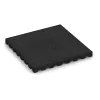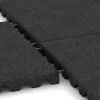The handy acoustic tiles quieten every kind of vibrations, i.e. structure-borne noise, impact noise and airborne noise. They can be laid as a base below the appliances, machines and devices, so that they effectively decouple them from the ground below, e.g. a storey ceiling.
They can be also used as an interior wall panelling (with the frustums oriented to the noise source) for housings - due to the favourable shaping and formulation they are able to quieten also the arising airborne noise.
The acoustic tiles are pasted with the flat side on the wall surface or on a base plate (plywood, galvanised sheet metal, etc.). With some hidden hooks, the base plate can be removably hung on a wall. The acoustic tiles are not directly screwed on.
Discount:
- £34.80 / 4 piece / m²
- (6.40 kg / piece)
-
Realisation time approx.
7-14 days
Properties

Colour

Material The rubber granulate with irregularly formed particles is obtained from discarded tyres. It mainly consists in the high-valuable mix of natural rubber (NR) and synthetically manufactured Styrene-Butadiene Rubber (SBR). The material properties of the WARCO preform largely correspond to those known from SBR. The granulate with an edge length from 1.0 to 3.0 mm creates fine-grained surfaces.

Connecting system The tiles are laid edge to edge in the 50% offset. This means, the plates in one row are displaced a half-length of the tile towards the adjacent rows. Four plastic connectors included to each tile join the adjacent rows together. Every plate is connected to 2 tiles from the previous and 2 tiles from the next row. However, this connection is not stable and doesn't prevent the plates from drifting apart, so that the surface has to be bordered.

Structure of the underside
Characteristics
Limitedly UV resistant
The ageing and lifetime of the product depend on the intensity of the UV radiation (sunlight).
Hygienically harmless for humans and animals
No prohibited pollutant emissions. Virtually odourless (initial odour evaporates).
Just paste it on
Paste on an appropriate base course with WARCO PU glue at some points or on entire surface.
Well and favourable invested money
Safe investment due to the original WARCO product with 5 years warranty - proved thousands of times.
Weatherproof - in the open air and in buildings
For applications in the open air and under roof. Avoid waterlogging and permanent drenching.
Normally inflammable
Building material class Efl (EN 13501-1), B2 (DIN 4102-1). Authority denomination: normally inflammable.
























































